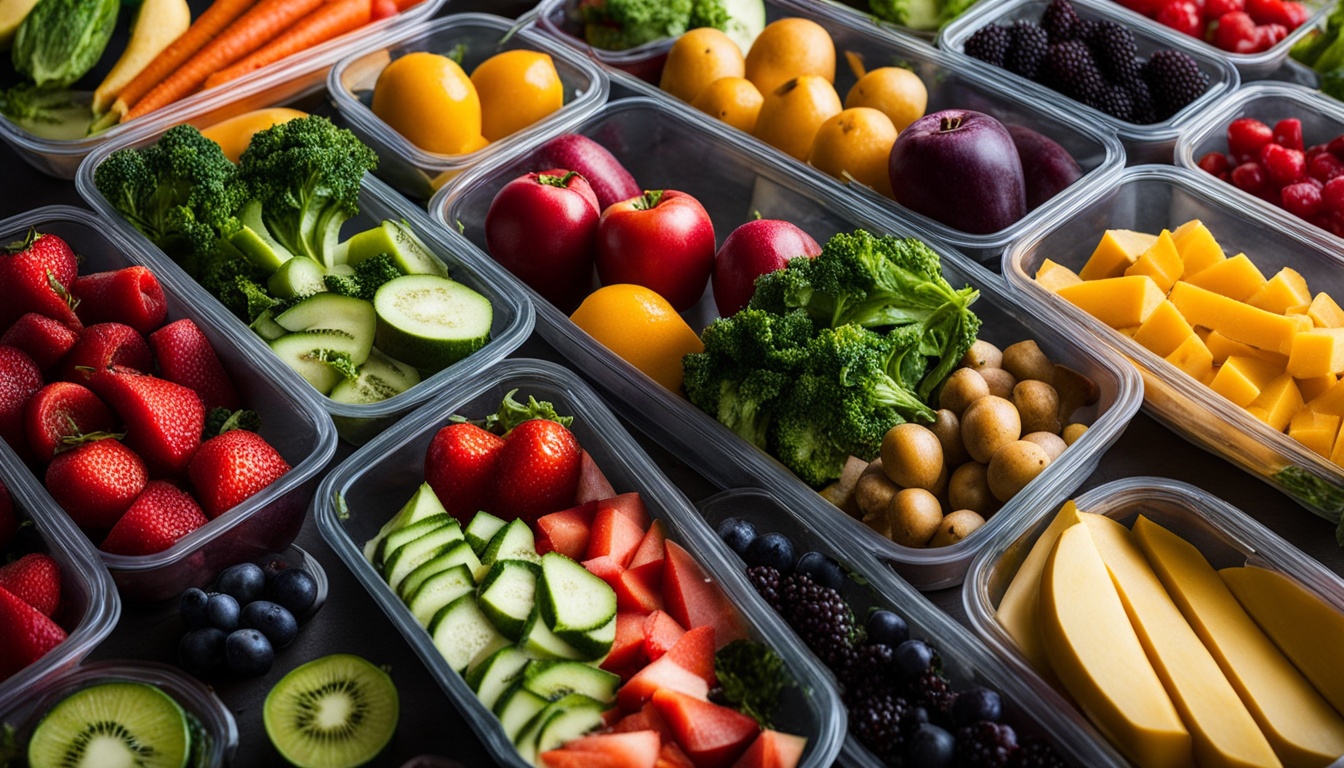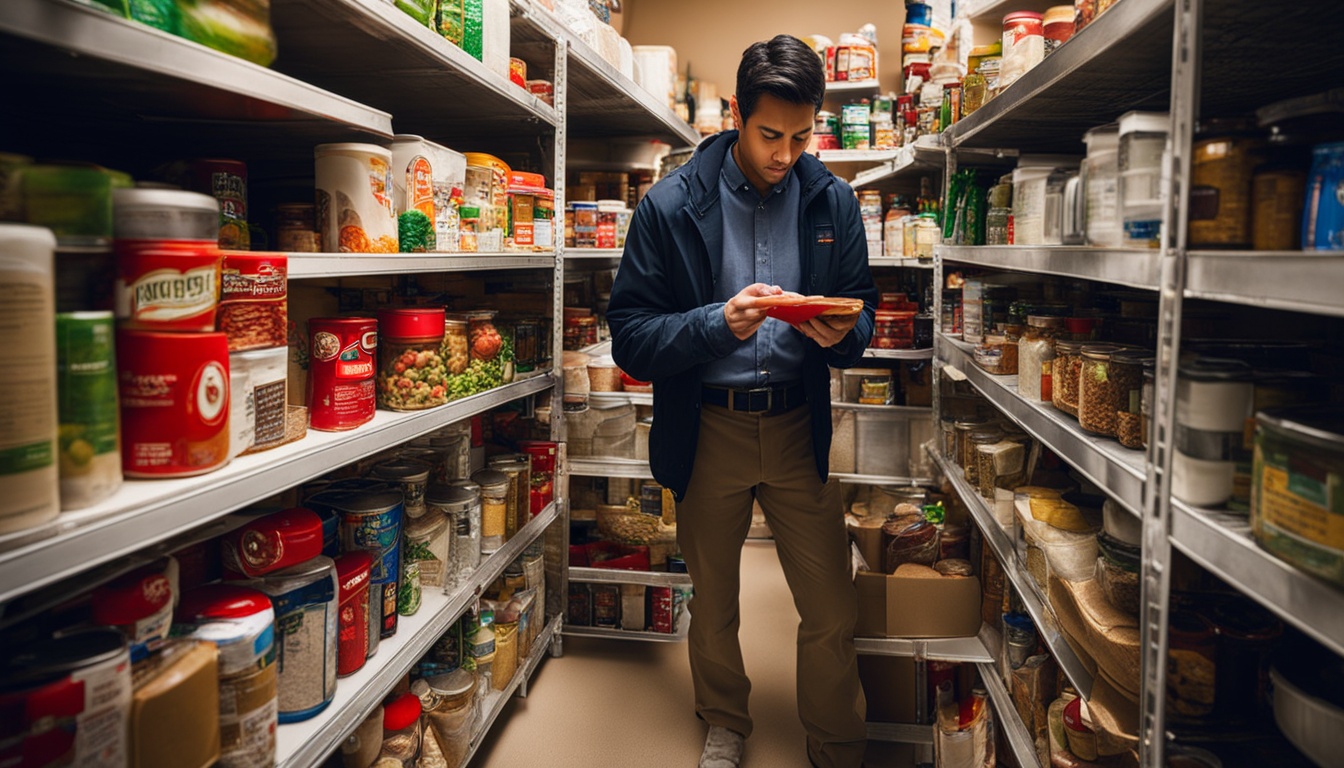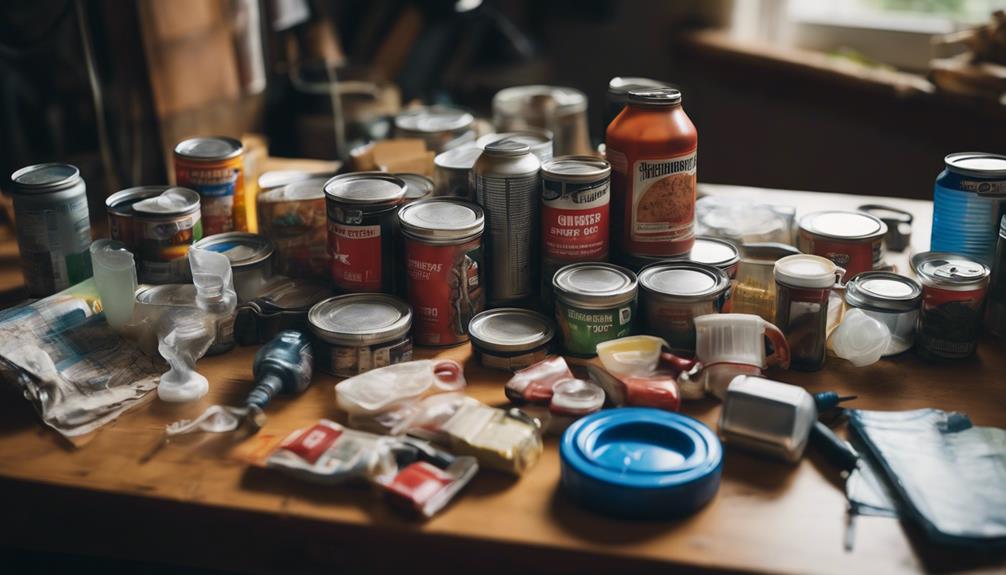Imagine getting home tired and hungry after a long day. You don’t want to spend your precious time cooking. Meal prepping offers a great solution. It saves time, promotes healthy eating, and helps reduce stress1.
Many who want to eat well choose meal prepping. It’s about making meals and snacks ahead of time. This way, you always have healthy options ready. It’s perfect for busy workers, students, or parents with lots to do. Meal prepping changes the game for eating healthy1.
Key Takeaways:
- Meal prepping saves time and reduces stress associated with meal planning and decision-making1.
- It leads to more thoughtful meals, providing balanced nutrition and preventing unhealthy food choices1.
- By reducing food waste, meal prepping can help in saving money1.
- Consistency in eating habits throughout the day is encouraged, aiding in weight management and hunger control1.
- Meal prepping strategies include making individual portions, cooking in batches, ingredient prepping, and creating freezer meals to cater to different preferences and needs1.
The Health Benefits of Meal Prepping
Meal prepping is a great way to stay healthy. It helps you control what you eat, saves time, and cuts stress. By planning meals ahead, you’re in charge of your diet.
Meal prepping makes it easy to choose balanced meals2.Most restaurant meals don’t meet health standards. But, planning helps you stick to healthy foods. You can fill your meals with fruits, vegetables, whole grains, and lean protein.
This method leads to eating more varied, quality foods. People who spend time preparing their meals eat more veggies and fruits2. A diverse diet boosts your health and happiness.
It’s also good for managing your weight. Takeout often has more calories and fat than homemade meals2. Meal prep can help you lose weight by controlling portions and picking healthy ingredients.
Meal prepping cuts down on food waste. In the U.S., a lot of food gets thrown away2. When you plan and buy just what you need, you help save the planet and resources.
It also saves money. Planning your meals avoids buying things you don’t need23. This way, you waste less and keep more cash in your pocket.
There are mental perks, too. People who meal prep say they feel less stressed and happier2. It gives a sense of control and order, making life a bit easier.
Overall, meal prepping is good for many reasons. It improves your diet, helps control weight, reduces waste, and makes you feel better. Put some time into it, and you’ll see how it changes your life.
How to Start Meal Prepping
Meal prepping makes it easy to have healthy meals ready all week. It saves time and ensures you’re eating well. To succeed, plan your meals and get cooking ahead of time. Here are some tips to get you on the right track with meal prepping:
1. Choose Your Meal Prep Method
There are many ways to meal prep, based on what you like. You might make single servings, big batches, just prep ingredients, or freeze meals. Try different methods to see which one fits your lifestyle best4.
2. Plan Your Meals
Start by planning your weekly meals. Think about what you like to eat and your health goals. Make sure you have everything you need for these meals45.
3. Make a Prep Day Game Plan
Pick a day each week to prepare your meals. Use this time to cook and get ready for the week. A clear plan will help make this process smooth and fun5.
4. Invest in Storage Containers
Good storage is key for keeping meals fresh. Choose containers that are safe for the microwave, dishwasher, and freezer. Quality containers help your food last longer56.
5. Cook and Assemble
On your prep day, cook your meals. Then, divide them into containers. This makes it easy to grab a meal whenever you need one. It saves time and cuts down on stress4.
6. Enjoy the Benefits
Meal prepping has lots of advantages. It saves time, money, and reduces food waste. It also helps with sticking to your diet and avoiding fast food. Whether you’re eating better, losing weight, or building muscle, meal prepping can help56.
Starting to meal prep might take some getting used to. Keep trying and adjust as needed. Soon, you’ll find meal prepping a great addition to your weekly routine.
Tips for Planning and Preparing Meals
Meal planning and prep can be simple with the right tips. They help you stay organized and efficient. This way, you save time, cut down on waste, and enjoy tasty, healthy meals all week.
Let’s look at some tips and tricks for meal prep:
1. Choose Simple and Versatile Recipes
Pick recipes that are straightforward and work for various meals. This cuts down on waste by reusing ingredients. Including different proteins, veggies, and whole grains ensures a well-rounded diet7.
2. Create a Grocery List and Stock Up on Pantry Staples
Make a list before you shop to stay on track and avoid buying things you don’t need. Keep essentials like grains, beans, and oils in your pantry8.
3. Invest in Quality Storage Containers
Good containers keep your food fresh and make meal prep easier. Look for durable, leak-proof options with compartments7.
4. Make Extra Meals for Freezing
Cook in bulk and freeze extra portions for later. It’s a time-saver and means you always have food ready8.
5. Label and Prioritize Packed Containers
Label your meals with the contents and date made. It helps you eat foods before they expire7.
6. Add Flavor and Variety
Use herbs, spices, and dressings to make meals tastier. Trying new flavors keeps your meals interesting7.
7. Engage with an Online Community or Involve Family Members
Connect with meal prep fans online or get your family involved. Sharing experiences can inspire you and make prepping fun7. Additionally, you can explore different recipe ideas and techniques from others, which may help you avoid getting stuck in a routine. If time or creativity is a challenge, consider looking for “meal prep services near me” to save time without compromising on healthy, homemade meals. Many services offer customizable options so you can still enjoy variety while sticking to your nutrition goals.
These tips can help streamline your meal prep, making your week smoother and meals more enjoyable. Meal prep is unique to each person, so adapt and find what fits your lifestyle. Enjoy your meal prepping journey!
Maximizing Variety and Avoiding Boredom
When prepping meals, it’s essential to mix things up to prevent boredom. Offering a variety of dishes keeps everyone happy and looking forward to mealtime9.
Finding meals you love is key to avoid getting tired of meal prep. Trying new recipes and flavors makes cooking fun. Adding different tastes and ingredients keeps your food exciting9.
Customizing meals to fit dietary needs or personal likes is smart. It means every dish can match your taste and health goals9. This way, everyone in the family can enjoy their favorite foods.
Get your family involved in meal choices. This adds fun and variety to cooking. Everyone feels part of meal times, making them more enjoyable9.
It’s important to have a mix of new and regular meals. Repeating some meals can simplify prep but still allow for new tastes9. This balance keeps your favorite dishes in the rotation while exploring new ones.
Breakfast is perfect for trying out new meal prep ideas. Overnight oats can change daily with different toppings. For a savory option, bulk-prep breakfast sandwiches offer variety through customization9.
Lunch and dinner can stay interesting with a simple base of protein, veggies, and rice. Then, mix things up with various seasonings, sauces, and fresh ingredients9. Daily bowl variations are a great way to keep meals fresh and exciting.
Don’t forget about snacks. Switching up snack options keeps things interesting and satisfies different cravings throughout the day9.
Using the same ingredients in various meals simplifies prep and introduces new flavors910. It’s an efficient way to enjoy diverse meals without extra hassle.
With creativity and customization, meal prepping can be an exciting culinary journey. Embrace new flavors and dishes to prevent boredom and ensure healthy eating for your family9.
| Statistical Data | Source |
|---|---|
| Americans who cook at home typically spend more than 7 hours a week on food preparation and cleanup | 11 |
| Meal prepping can help individuals save up to 15.8 days per year by cooking a week’s worth of meals within 1 to 4 hours | 11 |
| Choosing to meal prep can help individuals save up to $215,000 over time | 11 |
| Planning meals ahead of time could lead to a more nutritionally balanced diet and potentially help in weight control | 11 |
| Adults generally rotate through about 10 lunch and dinner ideas regularly | 11 |
| Meal prepping can reduce decision fatigue and boost productivity by eliminating the need to decide what to eat daily | 11 |
| Meal prepping can save money by reducing costs to less than $8 per meal, compared to buying lunch daily at $15 | 10 |
| The weekly grocery shop for meal prepping can provide food for at least 4 days, with additional items for future meals, freezer storage, fresh produce, and canned goods | 10 |
| Planning to freeze at least one or two containers of prepped meals provides variety for busy weeks or when traveling | 10 |
| Choosing recipes with similar ingredients but different flavors can prevent boredom during the week | 10 |
| Using detailed grocery lists down to ounces or cups of ingredients can help save money and reduce waste | 10 |
| Spreading out grocery shopping over more than one day can save time and make the process more manageable | 10 |
| Preparing storage containers ahead of time and labeling frozen meals with dates and contents can contribute to efficient meal prep | 10 |
| Doing “mise en place” by prepping ingredients before cooking can save time and help focus during the cooking process | 10 |
| Meal prep can extend beyond dinner to include breakfast options like chia seed pudding for a nutrient-packed grab-and-go meal | 10 |
| Shifting the mindset around meal prep to view it as a way to respect time and create delicious, healthy meals can improve the overall experience | 10 |
Meal Planning for Efficiency
Meal planning is all about repetition. Pick a few go-to meals for your week. Then, use batch cooking and ready-to-cook ingredients to make life easier.
Emily Davidson, from the University of Alabama at Birmingham, talks about meal prepping12.It saves time and money, and keeps you eating healthy.
Set a day each week for meal planning12. Sunday or Monday work best. This way, you start your week organized.
Batch cooking helps a lot12. Make big portions of soups and casseroles. They’re a lifesaver on busy days.
Prep your ingredients before you need them12. Cut up veggies and marinate your meats. It makes weeknight cooking a breeze.
Cook a lot of protein early in the week12. Use it in different meals to save time and add variety.
Try using slow cookers and sheet pans12. They make cooking easier and save you time.
Figuring out meal planning takes some experimenting12. Be patient and keep trying new methods until you find what works for you.
Efficient Meal Planning Tips:
- Choose a few staple meals for the week
- Utilize batch cooking techniques
- Prep ingredients in advance
- Strategically cook proteins that can be used in multiple dishes
- Incorporate smart cooking tools
- Stay open to trying new strategies
These tips will help you make a meal planning routine. It saves time, effort, and money. And you get to enjoy tasty, healthy meals all week.

Freezing and Storing Meals
Freezing meals is both handy and efficient. It helps keep food fresh for longer. You’ll always have something quick to eat. Meal prepping or saving leftovers is easier with the right freezing and storing methods. This keeps your food tasty and safe13.
Why Freeze Meals
Since 2017, freezing meals has become very popular. It led to the rise of meal prep businesses13. Freezing is different from refrigeration. It keeps food good for much longer, without losing flavor or quality13.
Most foods can be frozen, except eggs in shells and canned goods, according to the USDA13. Freezing meals saves time, money, and reduces food waste13.
What Freezes Well
- Stocks, soups (without noodles or cream), and sauces (without cream) freeze great. They’re ready when you are13.
- Stews, muffins, and breads keep well in the freezer too13.
Some foods don’t freeze as well. Leafy greens and veggies are great in cooked dishes after freezing13. Heavy cream can be used in soups, even if it separates. Al dente pasta freezes better13.
Don’t freeze soft cheeses like ricotta and cottage cheese. They won’t be the same when thawed13.
Popular Freezer Meal Ideas
Need some meal ideas? Try these for starters:
- Lasagna
- Shepherd’s Pie
- Steel-Cut Oats
- Zucchini Bread
- Cookie Dough
- Breakfast Burritos
Storing and Reheating Frozen Meals
Use airtight containers or freezer bags to keep frozen meals fresh13. Don’t forget to label and date them. This helps you track and use meals on time14.
When reheating, safety first. Heat your meals to at least 165 degrees Fahrenheit14. Reheating in the microwave might change the taste. Try the oven, stove, or eat them cold in salads or wraps14. Just don’t reheat a meal more than twice15.
Learning to freeze and store meals well lets you enjoy your favorite foods longer. It helps cut down on waste and keeps tasty, healthy options ready anytime.

Meal Prep for Beginners
Meal prepping is an amazing way for newbies to manage their meals and eat healthy during the week. It’s all about planning and preparing. Doing this can save you a bunch of time, cut down your stress, and keep you eating right.
Here are some great tips and ideas to help kickstart your meal prep journey.
Keep It Simple
Start with simple meals and slowly add more variety. Figure out what you like and how foods change when stored. Try a combo like chicken, quinoa, and veggies. Then, mix it up with different toppings and flavors.
Choose the Right Containers
What you put your meals in matters a lot. You can use plastic, glass, or metal containers for cold stuff. Zip-top bags and sealable containers are perfect for keeping ingredients separate and dressings from leaking.
Having different containers helps you organize and store your food properly.
Plan Your Meals and Shopping List
Planning meals and making a shopping list before going to the store saves time and money. Think about what grains, proteins, and veggies you want. A good shopping list makes grocery trips fast and simple.
Prep in Batches
Cooking in large amounts is a great time-saver. Make big portions of your main ingredients. This way, you have meals for days. Mix up your meals to keep things interesting. Freezing is an option for dishes like soups and chilies.
Just leave some space in the containers for food to expand. Heat them to 165°F when you’re ready to eat. Meal prepping can be easy once you get the hang of it. Find what works for you, whether it’s prepping just one meal or making extra for freezing. It’s all about making healthy eating fit your life.

| Statistical Data | Source |
|---|---|
| Meal prepping generally refers to preparing 3-7 days worth of food at a time, emphasizing the efficiency and convenience it offers. | 16 |
| Meal prepping is more common for individuals or small groups rather than whole families, due to the complexity and the need for numerous containers that prepping for a family entails. | 16 |
| About four days is typically the maximum duration suggested for prepped meals in the refrigerator per FDA guidelines, as food quality starts to decline after this period. | 16 |
| Starting small is advised when beginning meal prepping to understand personal preferences and texture changes that might occur. Gradually increasing the complexity and quantity of prepped meals is recommended. | 16 |
| Different formulas can guide the selection of foods for meal prepping, such as Basic (Protein + Grain + Vegetable), Low Carb (Protein + Vegetable + Vegetable), or Vegetarian (Legume + Grain + Vegetable), which can be adapted with toppings for variety. | 16 |
| The choice of containers for meal prepping varies from reusable plastic containers to glass ones, as well as metal bento box style containers for cold meals. Zip top bags are also recommended for separating ingredients, along with resealable containers for dressings and dips. | 16 |
| Meal prep can involve spending as little as 30 minutes planning and prepping meals, making it easier to eat well during the week. | 17 |
| Different meal prep methods include making ahead meals, batch cooking/freezing, individually portioned meals, and ready-to-cook ingredients. | 17 |
| Setting aside time for meal prepping is important, and it may not be reasonable to cook five meals in an hour. | 17 |
| Stocking up on pantry staples simplifies meal prepping, and building a better shopping list can help navigate the grocery store quickly. | 17 |
| Cut vegetables like onions and peppers will keep for two to three days in the refrigerator, while lettuce and greens can stay fresh for up to a week. | 17 |
| Cooked vegetables, grains, and dishes containing meat should be consumed within three to four days when stored in the refrigerator. | 17 |
| Foods like soups, chilies, casseroles, and cooked grains can be frozen for future meals, with a recommended consumption within three to six months. | 17 |
| With practice, individuals can find a meal prep style that works best for them, whether it involves prepping ingredients for one meal, preparing work lunches, or cooking double batches for freezing. | 17 |
| Date of publication: September 3, 2013 Number of comments: 309 Types of meal prep containers recommended: MealPrepster, Isolator Fitness, Bebox, Meal Preppies Recommendation to have a variety of tupperware containers on hand for meal prepping Meal planning guideline: Protein + Starch + Vegetable (with healthy fats) Protein options suggested: Chicken Breasts, Ground Beef, Ground Turkey, Fish, Eggs, Vegetarian options (such as beans, tofu, tempeh) Starch options recommended: Quinoa, Sweet potato, Brown rice, Pasta, etc. Vegetable options favored: Spinach, Green Beans, Mushrooms, Asparagus, etc. Meal prep suggestions: Cook enough protein, veggies, and starches for the week, or cook two meals to alternate Meal prep methods: Basic Meal Prep and Meal Prep Dinner Based Different levels of meal prep intensity: Beginner to intermediate vs. advanced prepper Meal prep frequency: Prepping for four to five days worth of dinner and a few days of breakfast Meal prep flexibility: Encouragement to adapt meal prep schedule to personal preferences and availability Example of a prepped meal: Turkey burger, sweet potato, green beans, and mushrooms stored in portioned tupperware container. |
18 |
Conclusion
Meal prepping is great for those wanting to stay healthy while saving time and money. It lets you have meals ready quickly during the week. Statistics show meal prepping saves 2-3 hours weekly, giving you more time for fun activities. It makes cooking efficient and supports a steady healthy diet all week19. Over 70% of meal preppers say they eat healthier and feel better20.
Meal prepping also cuts food costs by about 25% each week20. It helps you avoid buying food on a whim and use what you have more wisely. This approach is smart for those watching their spending.
Some may find it hard to stick with meal prepping or get the portions right at first19. Yet, the pros of meal prep beat the cons. It gives you more food choices, lets you customize meals, and keeps food fresh19. You get to enjoy tasty, healthy meals without losing quality or variety19.
Meal prepping makes healthy eating simpler and improves your day-to-day life. It leads to saved time, lower stress, better meals, and money saved19. Starting your meal prep journey can make your life easier and healthier. Give it a try!
FAQ
What are the benefits of meal prepping?
How can meal prepping help with weight loss?
What are the different ways to meal prep?
What storage options should I consider for meal prepping?
How should I plan my meals for meal prepping?
What should I consider when shopping for meal prepping?
How can I prevent meal prep boredom?
How can repetition help with meal planning?
What is the best way to freeze and store meals?
How can meal prepping benefit beginners?
Source Links
- https://health.clevelandclinic.org/a-beginners-guide-to-healthy-meal-prep – A Beginner’s Guide To Healthy Meal Prep
- https://www.everydayhealth.com/diet-nutrition/scientific-benefits-of-meal-prepping/ – 8 Scientific Benefits of Meal Prepping
- https://fitmencook.com/blog/benefits-of-meal-prepping/ – 9 Scientific Benefits Of Meal Prepping – Fit Men Cook
- https://www.plantoeat.com/blog/2023/01/the-ultimate-guide-to-meal-prepping/ – The Ultimate Guide to Meal Prepping
- https://fitmencook.com/blog/how-to-meal-prep/ – How to Meal Prep – Fit Men Cook
- https://mealprepmanual.com/beginners-guide-to-meal-prep/ – The Beginner’s Guide to Meal Prep – THE MEAL PREP MANUAL
- https://www.everydayhealth.com/diet-nutrition/meal-prep-tips-every-beginner-should-know/ – 10 Meal Prep Tips Every Beginner Should Know
- https://www.healthline.com/nutrition/meal-prep-tips – 23 Tips to Ease Meal Prep
- https://theeverygirl.com/base-meal-prep-method/ – This Easy Meal Prep Hack Ensures I Never Get Sick of My Meals by the End of the Week
- https://www.ninaknowsfood.com/blog/2019/3/11/how-to-make-meal-prep-more-enjoyable – How To Make Meal Prep Not Suck — Nina Knows Food
- https://biointelligentwellness.com/how-to-meal-prep/ – How to Meal Prep? – A Complete Guide for Beginners
- https://www.uab.edu/news/youcanuse/item/13811-meal-planning-magic-save-time-with-these-strategies-by-working-smarter-not-harder – Meal planning magic: Save time with these strategies by working smarter, not harder
- https://www.soupercubes.com/blogs/blog/how-to-freeze-meal-prep-guide – How to Freeze Meal Prep: The Ultimate Guide
- https://www.callmebetty.com/how-to-prepare-freeze-thaw-and-reheat-your-freezer-meal-prep-so-it-tastes-amazing/ – #29 How to prepare, freeze, thaw, and reheat your freezer meal prep so it tastes amazing
- https://idealnutritionnow.com/blogs/news/how-store-meal-prep-food-beginners-guide – How to Store Meal Prep Food – The Beginner’s Guide
- https://www.budgetbytes.com/meal-prep-101-a-beginners-guide/ – Meal Prep 101: A Beginners Guide to Meal Prepping – Budget Bytes
- https://www.eatingwell.com/article/290651/a-beginners-guide-to-meal-prep/ – A Beginner’s Guide to Meal Prep
- https://www.eatsandexercisebyamber.com/home/meal-prep-for-beginners – Meal Prep for Beginners
- https://blog.eatwithnymble.com/post/batch-cooking-vs-meal-prep – Nymble Blog – Batch Cooking vs Meal Prep: Which is better?
- https://eatcleanbro.com/blogs/blog/how-meal-prepping-can-save-you-time-keep-you-consistent – How Meal Prepping Saves Time & More – Blog | Eat Clean Bro










